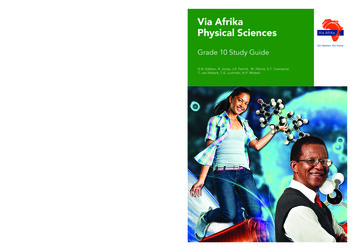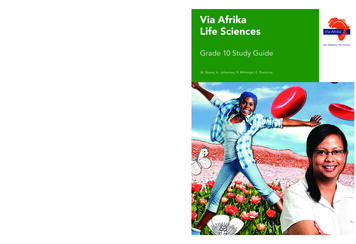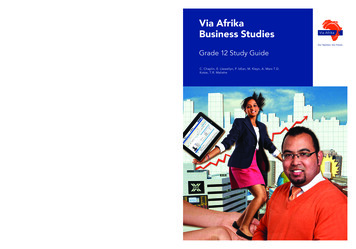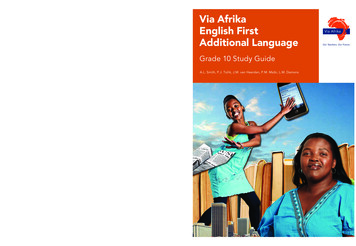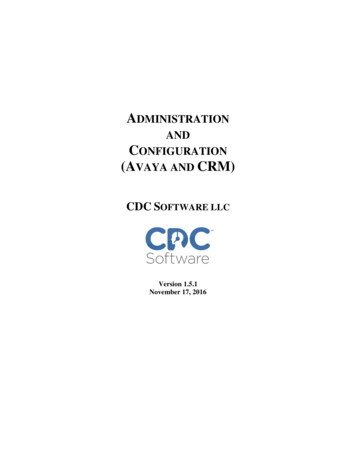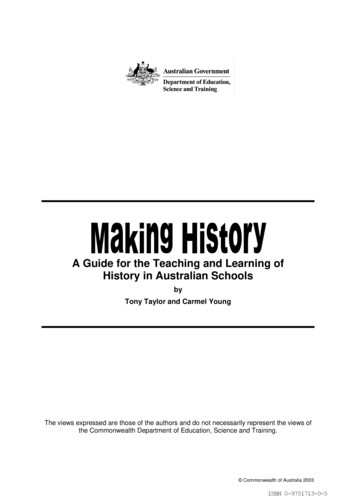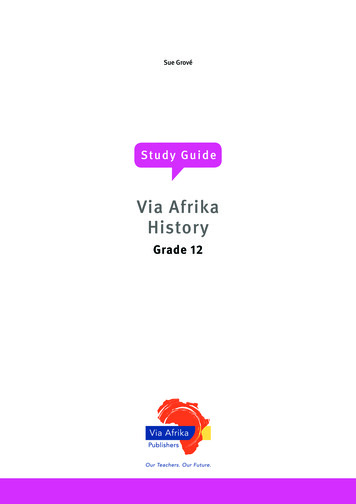
Transcription
Sue GrovéStudy GuideVia AfrikaHistoryGrade 12
ContentsIntroduction. 1Topic 1: The Cold War. 2Unit 1: What were the origins of the Cold War?. 3The extension of the Cold War – Case study 1: China. 7The extension of the Cold War – Case study 2: Vietnam. 13Summary and questions. 19Topic 2: Independent Africa. 23Unit 1: The ideas that influenced independent African states. 24Case study 1: Congo and Tanzania: A comparative case study. 26Unit 2: The impact of internal and external factors on Africa. 34Unit 3: Africa in the Cold War.35Case study 2: Angola.37Summary and questions.45Topic 3: Civil society protests: 1950s to 1970s. 49Unit 1: Overview of civil society protests.50Case study 1: The US Civil Rights Movement. 60Case study 2: The Black Power Movement. 67Summary and questions. 71Topic 4: Civil resistance in South Africa 1970s to 1980.75Unit 1: South Africa in the 1970s and 1980s. 76Unit 2: Challenge of Black Consciousness to the apartheid state. 80Unit 3: The crisis of apartheid in the 1980s. 83Summary and questions. 94
Topic 5: Democracy in South Africa and remembering the past. 99Unit 1: Negotiated settlement and Government of National Unity.100Unit 2: How has South Africa chosen to remember the past?.113Summary and questions. 122Topic 6: The end of the Cold War and a new world order. 129Unit 1: Events leading to the end of the Cold War. 130Unit 2: The End of the Cold War – The events of 1989. 133Unit 3: A new world order. 140Summary and questions. 149Suggested answers. 155
Examination hints123456789The underpinning context of history in Grade 12 is the politics of the Cold War. Thisis reflected in the multiple perspectives on the same events that occurred throughoutthe Cold War (e.g. multiple perspectives on the Cuban Missile Crisis). Keep this inmind when interpreting sources.Always refer to the attribution of every source and try to again as much informationas you can about the origins of the source, its purpose, when it was made or written.Look for clues in all sources and place it in its correct historical context. If there is adate, use it to assist you to place it in context.Use the glossary and textboxes in the Learner’s Book to increase your understandingand vocabulary. Use historical terms and concepts confidently and in the correctcontext.Try to identify leaders, symbols, clues, etc. and refer to these when you interpretsources. Ensure that you are able to link factions to the relevant leaders and theirideologies that shaped many Cold War conflicts (e.g. the Angolan Civil War).Never assume the examiner, teacher or marker knows what you mean – state yourpoint of view clearly.Link sections to past knowledge. Your knowledge on the Cold War period andcolonialism will be useful to interpret questions in this section.Try to make the content knowledge your own and avoid merely memorising thesesummaries or sections from the Learner’s Book. Use your own words and makesimple summaries to help you with your memorisation.The Learner’s Book has many examples of types of questions to practise. By doingthis regularly and consolidating daily, you will be successful.
IntroductionWho are you? Why are you here?Where are you going? How will you get there?These are some of the questions that History can help you to answer.From studying the past, we can learn how to live in the present. We can see whatmistakes were made and we can avoid repeating them in the future. By studying thesemistakes made in the past, as well as many correct and courageous decisions, we canunderstand why our world is like it is today.History is the study of people: famous people, notorious people and ordinary people,and how their decisions and actions shaped the future. Studying these people caninspire us to take a more active role in shaping our world and striving to achieve ourindividual potential. History is an exciting and dynamic subject. Studying History canhelp you to understand and speak intelligently about what is happening in the world.History is full of details, such as events, dates and names of people and places.However, when you study History, don’t worry about getting overwhelmed by all thedetails. Try to see the importance of the bigger picture.To do well in History, here are some strategies that you can use: Listen carefully in class.Ask your teacher questions until you understand what is going on.Go over the work you did in class that day.Do your own extra research on the topic you are studying.Never leave your studying to the day before a test or exam.Make your own mind-maps and summaries.Never study without talking to yourself and giving yourself short tests.In Grade 12 the key question you must investigate and answer is: What is the nature ofthe post-Second World War world? Via Afrika Publishers » History 12 Study Guide eBook1
Topic1The Cold WarOverviewIn this topic you will revise: The origins of the Cold War at the end of World War II, the creation of spheres ofinfluence by the two superpowers, containment vs. brinkmanship in Europe and theCaribbean (Cuba).The extension of the Cold War: Case studies: China and Vietnam.UNIT 1Page 3What were the originsof the Cold War ? Long-term and immediate causes Nature of the Cold War Installation of Soviet friendly governments insatellite states. USA’s policy of containment: Truman Doctrine andMarshall Plan Berlin Crises 1948 – 1961 Opposing Military alliances: NATO and Warsaw Pact. Containment and brinkmanship: the Cuban crisis.TOPIC 1 Page 2–22The Cold WarCASE STUDY 1Page 7The extension of theCold War – CASESTUDY 1: ChinaCASE STUDY 2 Page 13The extension of theCold War – CASESTUDY 2: Vietnam2 The events leading to the establishment ofCommunist China in 1949 (non-examinablebackground information) The Cultural Revolution Chinese relations with the USSR and the USA from1949 to 1973 China’s foreign relations with her neighbouringstates China’s world power status by the time of Mao’sdeath Improved relations between China and the USAafter 1970 The impact of economic liberalisation on foreignrelations since Mao’s death. Background to the struggle against the colonialpowers. Stages of the war. How is the Vietnam War remembered today? Via Afrika Publishers » History 12 Study Guide eBook
TopicUnit XXX1What were the origins of the Cold War?Key question: Why did a Cold War develop at the end of World War II and whywas it called the Cold War?Definition of the concept COLD WAR What was it? It is a state of military rivalry and political tension.What methods were used? Espionage, propaganda, backing up allies in conflicts, e.g. the Middle East,Europe, the Far East, Africa, etc.Who was primarily involved? The two superpowers, the USA and the USSR, and their respective allies.When did it occur? 1945 to 1989 – accepted as the official dates but some consider the start to be 1917when the Russian Revolution led to the establishment of the Soviet state and thatit ended when the Soviet Union collapsed and Germany was reunited.Where did it happen? It began in Europe and spread to other parts of the world.Why did it happen? There were many long-term and short-term causes:Causes of the Cold War World War II itself – the rift widened between the USA and the USSR.Stalin encroached on Eastern Europe during the last months of the war and theRed Army reached Berlin first.Poland was occupied by the USSR and Germany was split into four zones ofoccupation as the Allies could not reach consensus.Nuclear weapons deepened the suspicion and rivalry.It led to an arms race and development of deadly weapons of destruction.Two spheres of influence were established in Europe as Communist regimes wereestablished in the occupied states – these were termed satellite states.Rival ideologies (Communism vs. Capitalism) led to increased suspicion.Leadership rivalry: Truman was a hardliner who did not want to concede to Stalinand despised Communism.How did it happen? It was not a ‘hot’ conflict between the superpowers or direct, open, conventionalwarfare, but it operated through proxy wars and liberation struggles wherevulnerable states were manipulated to further ideologies and to extend thesphere of influence of the two superpowers. Via Afrika Publishers » History 12 Study Guide eBook3
Unit XX1What was Truman’s policy of containment? It was Truman’s policy after 1946 to use specific strategies to prevent the spread ofCommunism.Re-cap the decisions madeIt consisted of two components:at Potsdam and Yalta with the Truman Doctrineregard to Berlin and makesure you understand the the Marshall Plan (or European Recovery Plan).threat of open hostility between the two superpowers.The Truman DoctrineCrisis in Greece 1946 In March 1947 Trumanannounced thatthe US would assistGreece against theCommunists. Military andfinancial aid change in US foreignpolicy.European Recovery Plan (Marshall Plan) In June 1947 Marshall announced the EuropeanRecovery Plan to contain Communism in Europe. Aid was offered to any European state forindustrial and economic recovery. This would eradicate poverty andeconomic distress would prevent the spread ofCommunism.The USSR prevented the satellite states from accepting Marshall aid and formedthe Communist Information Bureau or COMINFORM to counter the US policy ofcontainment.Revise the map ofBerlin and the divisionof Germany in the LBbefore studying thissection.The Berlin Crises 1948–19611946 the threewestern zones inBerlin united toform West Berlin.The West did notwant to risk outrightwar with the USSRand introduced anairlift.1948 currencyreform wasintroduced in WestGermany to upliftthe economy.Stalin blockadedthe access routesto West Berlin.For 11 months Western aircraft airlifted essential food,medical and fuel supplies to West Berlin.4Stalin wanted the West towithdraw from West Berlinand hand over their zonesto the USSR.Currency reform in Berlin led to animprovement of the economy anddefectors left for West Berlin.In August 1949 Stalin lifted theblockade and reopened theroutes. Via Afrika Publishers » History 12 Study Guide eBook
Unit1West Germany became known as the German Federal Republic while East Germanybecame known as the German Democratic Republic. Standard of living low inGDR: led to migration toWest Berlin and strikes. Revolts crushed by authorities.Leader of GDR, Walter Ulbricht, closed theborder between East and West Berlin inAugust 1961 and soldiers erected a wall, guardtowers and armed guards to stop defectors.The Berlin WallAfter the Berlin Crises, two powerful military alliances were formed that effectivelydivided Europe into two armed camps by 1955:NATO was formed in 1949 by12 countries that agreed to unitethe armed forces of the Alliesin case of a nuclear threat orattack from the East.After West Germany joinedNATO in 1955, the USSR andits allies formed a secondpowerful military block calledthe Warsaw Pact.SIGNIFICANCE: The spheres were entrenched into two defence pacts and an arms racebegan to build between the superpowers.Containment and brinkmanship: The Cuban CrisisAnother tactic developed during the Cold War was brinkmanship. This is the practiceof pushing dangerous events to the edge (or brink) of disaster in order to gain anadvantage. Posturing and discrediting the opponent was used to portray the enemy ina negative light. These strategies were applied during the events in Cuba that led to theextension of the Cold War beyond Europe.Background to the Crisis Until 1959 US commercial farmers and businessmen had interests in Cuba. It wasa poor country, dependent on US sugar imports. The US turned a blind eye to thebrutality of the Cuban dictator, Batista.In 1959, Castro led a revolution and overthrew Batista’s regime. Via Afrika Publishers » History 12 Study Guide eBook5
Unit XX1 Castro announced plans to nationalise land in Cuba and indicated that he neededloans from the USA.The US refused to lend money to Castro as he was viewed to be Marxist. The USthreatened to cut sugar imports from Cuba.Cuba turned to the USSR and signed a trade agreement with Russia.In retaliation to US trade cuts, Cuba nationalised all American-owned companies.The CIA assisted a group of exiles with planning a counter- revolution againstCastro’s government.This invasion was a disaster and an embarrassment for Kennedy’s administration.Castro asked for weapons from the USSR to defend itself against the USA and hedeclared himself a Marxist.The US viewed Cuba as another Soviet satellite state.In June 1962, Cuba received shipments of arms and MIG-21 fighter jets from the USSR.Medium range missiles and bombers arrived.The Cuban Missile Crisis, 1962 On 14 October 1962, an American spy plane detected a nuclear missile base onthe island.Kennedy set up a special committee to advise him on the way forward.On 22 October, Kennedy announced a blockade of the island, which placed theisland under quarantine until the missile sites were removed.Khrushchev defended Soviet actions as an act of self-defence on Cuba’s side due tothe role of the USA in the Bay of Pigs disaster.Khrushchev accused the US of piracy and did not turn the warships around thatwere en route to Cuba.Letters were exchanged between the two leaders and the world waited anxiously tosee what would happen.Khrushchev offered to dismantle the Soviet nuclear missile bases in Cuba in returnfor the dismantling of US missile bases in Turkey.The crisis was averted by means of diplomacy.Once the crisis was averted there was a thaw in the Cold War: a hotline telephonelink was set up between Moscow and Washington as a direct line of contact.In August 1963 a Nuclear Test Ban Treaty was signed to end nuclear testing aboveground.In 1968 a Nuclear Non-Proliferation Treaty was signed, which aimed at preventingthe spread of nuclear weapons to countries that did not have them.6 Via Afrika Publishers » History 12 Study Guide eBook
Case Study1The extension of the Cold War – CASE STUDY 1: ChinaKey question: How did China rise as a world power after 1949?In this case study you will revise the following: NB: Check if youmust study Chinaor Vietnam foryour exam!The events leading to the establishment of Communist China in1949 (non-examinable background information)The Cultural RevolutionChinese relations with the USSR and the USA from 1949 to 1973China’s foreign relations with her neighbouring statesChina’s world power status by the time of Mao’s deathImproved relations between China and the USA after 1970The impact of economic liberalisation on foreign relations since Mao’s death.The establishment of Communist China in 1949(Background information only) Britain gained control of Hong Kong after the defeat of the Chinese imperial armyin 1842.The Chinese Emperor had to concede to increased control of trade by the Westthrough five treaty ports.Feudal warlords rose in revolt as the power of the emperor declined and China wassubjected to decades of conflict.European powers and Japan took advantage of the instability e.g. France drove outthe Chinese and colonised Vietnam, Russia occupied land in the north and Japancolonised Korea and annexed Taiwan.Change began to occur in the treaty ports as a new generation of Chinese leaderswho had been educated in the West assumed control, but the rural areas were stillunder strict imperial control.Between 1910 and 1912, Chinese nationalists rose up and declared theirindependence from the empire.A provisional government was set up under Sun Yat Sen in 1912, but it did notlast long.China was engulfed in a civil war, which was exploited by Russian Communistswho wished to expand their ideology.Although the Chinese Communists were part of the Nationalist alliance, thispartnership collapsed and after 1927 the Communists were targeted by the troops ofChiang Kai-Shek (he had replaced Sun Yat Sen).The Communists withdrew to the countryside and it became a party focussed on theneeds of rural peasants rather than industrial workers.The Nationalists got aid from the West while the Communists turned to the USSR. Via Afrika Publishers » History 12 Study Guide eBook7
Case studyUnit XX1 The Communists undertook the Long March in 1934 and Mao became the undisputedleader of the Chinese Communist Party (CCP).Matters became more complicated for the Nationalists when the Japanese attackedChiang Kai-Shek’s armies in 1936 and occupied Manchuria.After Japan’s defeat in 1945, a civil war between the Nationalists and theCommunists intensified. With the aid of Soviet support and support in the rural areas, the Communistforces were victorious. The Nationalists (Guomindang) fled to Taiwan and set up a democratic,capitalistic state.Mainland China became the People’s Republic of China in 1949, under theleadership of Mao Zedong.The Cultural RevolutionGOVERNMENT AuthoritarianExecuted upto 1 millionwarlords.LAND INDUSTRYMost of the richerpeasants could keeptheir land.Land taken fromwarlords was dividedamongst the landlesspeasants. CCP nationalisedheavy industry andforeign firmsLight industrycould be privatelyowned.Led to rapidgrowth.The Great Leap Forward 8WHY? Mao wanted to transform Chinese society to overtake capitalist countries andbecome one of the richest and most powerful countries in the world.HOW? The CCP forced individual farmers into Agricultural Cooperatives or ruralcommunes where all land was communally owned and workers were paidaccording to the amount of work they did. About 5 000 households weresupposed to start large-scale farms and backyard factories.WHAT happened? Many local party officials became corrupt and authoritarian. Initially the Chinesesupported the Great Leap Forward enthusiastically. Government propagandaprojected data that showed the programme to be successful. Via Afrika Publishers » History 12 Study Guide eBook
Case studyUnit XX1CONSEQUENCES: A spectacular failure:WHY? Poor planning and poor support for farmers.Corrupt local officials.Farmers were taxed on production, therefore production soon fell.Backyard factories consumed large amounts of raw materials and producedinferior goods.This was exacerbated by bad weather and failed harvests in 1961.FAMINE: 20-30 million Chinese people died.Mao allowed the moderates in the CCP to return to earlier policies to restart theeconomy.Great Proletarian Cultural Revolution IN MID-1960S ECONOMY BEGAN TO RECOVER BUT CLASS DIVISIONS BEGANTO RE-APPEAR.MAO WANTED TO RE-ASSERT HIS AUTHORITY.MAY 1966 MAO LAUNCHED MASSIVE CULTURAL RENEWAL MOVEMENT.HE MOBILISED THE YOUTH AND STUDENTS TO FORM THE RED GUARD TOATTACK TEACHERS.CAMPAIGN SLOGANS ATTACKED OLD IDEAS, TRADITIONAL CULTURE,CUSTOMS AND HABITS.RED GUARDS MOVED INTO SCHOOLS, COLLEGES, FACTORIES AND FARMINGCOMMUNES IN AN ORGY OF VIOLENCE.MAO PURGED THE CCP OF RIVALS: THOUSANDS TORTURED AND KILLED.MAO USED THE RED GUARDS TO SET UP A REIGN OF TERROR, BUT BY THELATE 1960s THE CULTURE OF VIOLENCE HAD SPUN OUT OF CONTROL.BY 1970 MAO USED THE ARMY TO BRING THE RED GUARDS UNDER CONTROL. Via Afrika Publishers » History 12 Study Guide eBook9
Case studyUnit XX1China’s Foreign PolicyUSSR USA Mao wanted to maintain a close relationship with Stalin and theCOMINTERN.Stalin mistrusted Mao’s ambitions within the COMINTERN and tried tolimit his power. National interests dominated relations.Feb 1950 USSR and China signed the Sino-Soviet Treaty of Friendship:China gained railway interests in northern China and joint industrialprojects began.When the USSR assisted North Korea with its invasion of South Koreain 1950, the USA used the UN to send in troops to launch a counterattack.Mao sent over a million troops to fight in Korea to gain prestige. Heseized grain and produce from Chinese farmers to feed the soldiers.About 900 000 Chinese troops died and there was much suffering.Mao blamed the US. He therefore supported Ho Chi Minh against theUS in the Vietnam War.The Sino-Soviet splitMao’s initial economic policiesled to classes and inequality. Tocounter this he reverted to trueMarxism, collective and stateownership (known as Maoism)and mobilised the peasantry. 10Khrushchev applieddeStalinisation policies anddenounced Stalin’s oppression.He allowed managers to usecapitalist methods to generategrowth. He allowed morefreedom of thought and debate.This threatened Communism inChina according to Mao.Ideological differences led to further alienation between Khrushchev and Mao.Serious territorial conflicts in Asia added to the tension e.g. Vietnam, Korea,Cambodia.Mao threatened the leadership of the USSR in the COMINTERN.Khrushchev thought he could control Mao.The USSR sent advisors to China to help develop an atom bomb.In 1959, the USSR broke off ties and withdrew the advisors and technicians.In 1964, China developed its own atom bomb.The USSR began to form alliances against China.The USSR and China did support Cuba in the Cuban Missile Crisis in 1962. Via Afrika Publishers » History 12 Study Guide eBook
Case studyUnit XX1China’s relations with neighboursChina’s foreign relations in AsiaTIBETVIETNAMINDIATAIWAN 1950 – Red Army 1945 – Mao put India recognised In 1949 Chiang’s occupied Tibet.Forced the DalaiLama to sign atreaty recognisingChinese control.1959 – uprisingagainst Chineserule cruellysuppressed.Tibet wasincorporated intoChina.More than 6 000monasteries weredestroyed andthousands ofmonks and nunswere killed.pressure on therevolutionaryleader Ho ChiMinh to applyMaoism in NorthVietnam. In the 1960sChina remaineda close ally of theCommunists inthe war. Tensionsincreased inthe 1970s whenChina seized oilresources in theGulf of Tonkin andwhen Vietnamhelped overthrowChina’s ally, theKhmer Rouge, inCambodia.the People’sRepublic of Chinain 1949 BUT China was nothappy with theborder drawn upby Britain betweenthe two countries. In 1962 Chinaattacked India as ashow of strength. In 2004 ChinarecognisedIndian rule overSikkim whileIndia recognisedChinese control ofTibet.nationalists fledto Taiwan and setup the Republic ofChina. A state of warexisted betweenthe two China’suntil 1972. The USA backedTaiwan andprotected theisland during theKorean War. In 1971 Maopersuaded theUN to make RedChina one of thepermanent fiveon the SecurityCouncil.Was China a Superpower when Mao Zedong died in 1976?TWO POINTS OF VIEW:YES NOExceptionally large state.Massive population.Large in terms of land.Has great military, political, economicand cultural influence. The economic destruction andcultural repression did not make it asuperpower. Its arsenal of weapons was not as strongas that of the USA or the USSR.Why China tried to improve relations with the USA after 19701To counter Soviet political and military pressure in Asia.2To increase its stature as a leading state in world affairs. Via Afrika Publishers » History 12 Study Guide eBook11
Case studyUnit XX1Evidence of improved relations: UN dropped her support for Taiwan as a member of the Security Council.1972: President Nixon visited China: US technical staff and writers visited ChinaSome Western literature was allowed into China, but was not widely distributed.Impact of China’s economic liberalisation since Mao’s deathWhat is economic liberalisation?In this context it would refer to the changes introduced after Mao’s death that showed adeviation from true Communist principles.Impact within China: introduced market socialism many of the state controlled farms were divided into individual family units againprivate citizens were encouraged to establish light consumer industriesencouraged an open door policy with the West to foster tradeabolished central planning and price controlsprivatised inefficient state-owned enterprises.Results: A new prosperous middle class developed in the cities, while richer peasantfarmers arose in the rural areas. China’s economy has grown phenomenally. These new policies have also caused hardship for many: poorer farmers havebeen forced off the land by richer farmers as the land has been consolidated.Unemployment has grown in the cities due to the migration from rural to urbanareas. Food prices have increased. China is still not democratic, and the authorities have dealt harshly with prodemocratic marches.Impact on rest of world 12West: Investment friendly policies and low wages to Chinese workers attractinvestment to China. Capital and technology have led to massive growth and productivity in China,making the West wary.Africa: China has expanded her interests in Africa and the BRICS countries.It is interested in the countless raw materials in Africa as well as agriculturalproducts. China provides a huge market for commodities and raw materials. This hasoften led to agreements with brutal dictators.Developing economies: China has invested in many developing economies andhas extended the infrastructure and markets there. It has also formed the China–Africa Forum to influence African leaders. Via Afrika Publishers » History 12 Study Guide eBook
Case Study2The extension of the Cold War – CASE STUDY 2: VietnamKey question: How was a small country like Vietnam able to win the war againstthe USA? (1945 to 1975)In this case study you will revise the following: Background to the struggle against the colonial powers.Stages of the war.How is the Vietnam War remembered today?NB: Check if youmust study Chinaor Vietnam foryour exam!Background: Vietnam’s struggle against the colonial powersChina ruled the area that became known as Vietnam for thousands of years. In the10th century Vietnam gained independence that lasted until the French colonised theregion after 1858. French missionaries helped to introduce French language, education,customs and religion. By 1864 a colony was established in the south called Cochinchina.China became involved in the region and it led to the Sino-French War 1864–1885. Chinahad to withdraw and the French established three regions of control in Vietnam. Thecontrol of the French was extended when it also occupied Laos and Cambodia. French colonial rule was politically repressive and economically exploitative. The French claimed to modernise Vietnam with a network of infrastructure, butthey also introduced forced labour, heavy taxes and a centralised government.Life for the Vietnamese peasants was hard.Vietnamese resistance was initially passive in nature, but as nationalism grew,resistance grew too. After World War I, Ho Chi Minh began coordinating the resistance: went to live in Paris in the 1920s where he became active in the FrenchCommunist Party. visited Moscow in 1924 and became convinced that a Communist inspiredrevolution was needed in Vietnam to shake off the yoke of colonialism. realised that nationalism would awaken an anti-colonial revolt. he operated from a base in China close to the border of Vietnam (faced arrestin his own country). organised Vietnamese nationalist exiles Vietnam Revolutionary League.Japan occupied Vietnam during World War II and the natural resources were used tofuel the Japanese war effort. He returned to Vietnam (1941) set up Viet Minh (Vietnam Independence League).He formed an alliance with the US to fight the Japanese in the Vietnam jungle.When Japan was defeated in 1945, the occupied territories were returned to France asFrench colonies. Via Afrika Publishers » History 12 Study Guide eBook13
Case studyUnit XX2 Ho Chi Minh’s guerrilla fighters occupied Hanoi and proclaimed a provisionalgovernment and he declared himself president of the Democratic Republic ofVietnam The US refused to recognise his state.After World War II: In September 1945 about 1 400 French soldiers freed fromJapanese internment camps went on the rampage attacking and killing many VietMinh guerrillas as well as innocent civilians. The Viet Minh retalia
Communist China in 1949 (non-examinable background information) The Cultural Revolution Chinese relations with the USSR and the USA from 1949 to 1973 China’s foreign relations with her neighbouring states China’s world power status by the time of Mao’s death Improved relati
